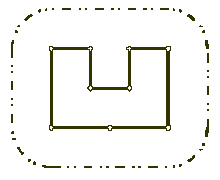poj1113Wall【凸包】
来源:互联网 发布:站长之家端口检测工具 编辑:程序博客网 时间:2024/06/05 03:15
Language:
Wall
Time Limit: 1000MS Memory Limit: 10000KTotal Submissions: 32437 Accepted: 11008
Description
Once upon a time there was a greedy King who ordered his chief Architect to build a wall around the King's castle. The King was so greedy, that he would not listen to his Architect's proposals to build a beautiful brick wall with a perfect shape and nice tall towers. Instead, he ordered to build the wall around the whole castle using the least amount of stone and labor, but demanded that the wall should not come closer to the castle than a certain distance. If the King finds that the Architect has used more resources to build the wall than it was absolutely necessary to satisfy those requirements, then the Architect will loose his head. Moreover, he demanded Architect to introduce at once a plan of the wall listing the exact amount of resources that are needed to build the wall.

Your task is to help poor Architect to save his head, by writing a program that will find the minimum possible length of the wall that he could build around the castle to satisfy King's requirements.
The task is somewhat simplified by the fact, that the King's castle has a polygonal shape and is situated on a flat ground. The Architect has already established a Cartesian coordinate system and has precisely measured the coordinates of all castle's vertices in feet.

Your task is to help poor Architect to save his head, by writing a program that will find the minimum possible length of the wall that he could build around the castle to satisfy King's requirements.
The task is somewhat simplified by the fact, that the King's castle has a polygonal shape and is situated on a flat ground. The Architect has already established a Cartesian coordinate system and has precisely measured the coordinates of all castle's vertices in feet.
Input
The first line of the input file contains two integer numbers N and L separated by a space. N (3 <= N <= 1000) is the number of vertices in the King's castle, and L (1 <= L <= 1000) is the minimal number of feet that King allows for the wall to come close to the castle.
Next N lines describe coordinates of castle's vertices in a clockwise order. Each line contains two integer numbers Xi and Yi separated by a space (-10000 <= Xi, Yi <= 10000) that represent the coordinates of ith vertex. All vertices are different and the sides of the castle do not intersect anywhere except for vertices.
Next N lines describe coordinates of castle's vertices in a clockwise order. Each line contains two integer numbers Xi and Yi separated by a space (-10000 <= Xi, Yi <= 10000) that represent the coordinates of ith vertex. All vertices are different and the sides of the castle do not intersect anywhere except for vertices.
Output
Write to the output file the single number that represents the minimal possible length of the wall in feet that could be built around the castle to satisfy King's requirements. You must present the integer number of feet to the King, because the floating numbers are not invented yet. However, you must round the result in such a way, that it is accurate to 8 inches (1 foot is equal to 12 inches), since the King will not tolerate larger error in the estimates.
Sample Input
9 100200 400300 400300 300400 300400 400500 400500 200350 200200 200
Sample Output
1628
图片转自:http://blog.csdn.net/zhengnanlee/article/details/9633357;
所以所求长度如图所示为凸包周长加以l为半径的圆的周长。因为绕周长一周所以为一个正圆
#include<cstdio>#include<cstdlib>#include<cstring>#include<cmath>#include<algorithm>#define PI 3.1415926#define eps 1e-8using namespace std;struct point{double x,y;}A[1010],result[1010];bool equal(double n){return fabs(n-0)<eps;}double cp(point p1,point p2,point p3){return (p3.x-p1.x)*(p2.y-p1.y)-(p3.y-p1.y)*(p2.x-p1.x);}double dist(point a,point b){return sqrt((a.x-b.x)*(a.x-b.x)+(a.y-b.y)*(a.y-b.y));}bool cmp(point a,point b){double ans=cp(A[0],a,b);if(equal(ans))return dist(A[0],a)-dist(A[0],b)<=0;else return ans>0;}int main(){int n,i,j,l;while(scanf("%d%d",&n,&l)!=EOF){int pos=0;for(i=0;i<n;++i){scanf("%lf%lf",&A[i].x,&A[i].y);if(A[pos].y>=A[i].y){if(A[pos].y==A[i].y){if(A[pos].x>A[i].x)pos=i;}else pos=i;}}double S=0;point temp;temp=A[pos];A[pos]=A[0];A[0]=temp;sort(A+1,A+n,cmp);int top=1;result[0]=A[0];result[1]=A[1];for(i=2;i<n;++i){while(cp(result[top-1],result[top],A[i])<0)top--;result[++top]=A[i];}for(i=0;i<=top;++i){S+=dist(result[(i+1)%(top+1)],result[i]);}printf("%.0lf\n",S+2.0*PI*l);}return 0;} 0 0
- poj1113Wall【凸包】
- poj1113Wall凸包入门题 模板
- poj1113Wall(凸包周长计算)
- poj1113Wall
- poj1113Wall
- poj1288poj1228Grandpa's Estate poj1113Wall
- POJ1113Wall(计算几何基础)
- 计算几何入门3--poj1113Wall
- poj1113Wall 求凸包周长 Graham扫描法
- 凸包
- 凸包
- 凸包
- 凸包
- 凸包
- 凸包
- 凸包
- 凸包
- 凸包。
- hdu4870Rating 概率dp
- 为什么学java开发?
- python 2 编码问题
- SpringMVC中使用Interceptor拦截器
- 中国足球深度剖析之五,破除周期性怪圈
- poj1113Wall【凸包】
- Java Serializable(序列化)的理解和总结
- vsftpd的配置详解(中文说明)
- 无法执行添加/移除操作,因为代码元素“CXXXDlg”是只读的
- java 大数加减法(小数,正负)
- CSS文本属性(下)
- UI初级之表视图UITableView自定义单元格
- ZOJ 3713 In 7-bit
- C++函数声明和定义深度解析(转)



